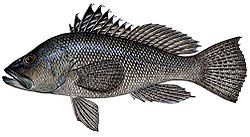- Black sea bass
-
This article is about the Atlantic black sea bass. For Pacific black sea bass, see giant sea bass.
Black sea bass 
black sea bass Scientific classification Kingdom: Animalia Phylum: Chordata Class: Actinopterygii Order: Perciformes Family: Serranidae Genus: Centropristis Species: C. striata Binomial name Centropristis striata
(Linnaeus, 1758)The black sea bass (Centropristis striata) is an exclusively marine fish. It is a type of Grouper (Serranidae) found more commonly in northern than in southern ranges.
It inhabits the coasts from Maine to NE Florida and the eastern Gulf of Mexico. There are three large biomass populations of black sea bass: one off the coast of Georgia and South Carolina, one in the area of the Chesapeake Bay, and one off New York. They can be found in inshore waters (bays and sounds) and offshore in waters up to a depth of 130 m (425'). They spend most of their time close to the sea floor and are often congregated around bottom formations such as rocks, man-made reefs, wrecks, jetties, piers, and bridge pilings.
Contents
Life cycle
The sea bass spawns when it is mature, at 190 mm (7.5"), in middle of May to end of June. The eggs, 0.95 mm (.03") in diameter, are buoyant and their development time is 1.6 days at 23 °C (74 °f). The maximum size of a sea bass is 500 mm (19.7"), weighing 4.3 kg (9.5lb).
It appears off New Jersey in the first weeks of May, withdrawing in late October or early November, and wintering offshore at 55 to 130 m (180'-426')at temperatures above 8 °C (46 °f). In summer it is most abundant at less than 37 m (120').
Identification features
- The spiny and soft ray portions of the dorsal fin are continuous, so there is only one long fin instead of two short separate ones as for the wreckfish Polyprion americanus, scup Stenotomus chrysops, rose fish Sebastes marinus, cunner Tautogolabrus adspersus, striped bass Morone saxatilis.
- Rounded caudal fin and pectoral fins, short but high anal fins.
- Compared to a tautog or cunner, its mouth is much larger, also the caudal fin, pectoral fin, and soft portion (11 rays) of dorsal fin as long as spiny portion.
- Compared to a wreckfish, its scales are much larger, the head outline and gill cover are smooth, and the caudal fin is rounded at the edges.
- It is stout-bodied, three times taller than long (without caudal fin), and has a high back, flat topped head, moderately pointed snout, large oblique mouth, eye set up high (not as high as in the above image due to its slightly oblique perspective), and one sharp flat spine near the caudal end of the operculum.
- The dorsal fin originates at the anterior of the caudal end of the operculum, the soft portion of the dorsal fin is more tall than long, the caudal fin is rounded and in adults it is an elongated upper ray, the anal fin originates below the soft portion of the dorsal fin, which it resembles in its rounded shape and being more tall than long.
- The pectoral fin is very long nearly towards the anal fin, rounded (best fieldmark), the pelvic fin is very large, originate posterior of pectoral fin (whereas slightly caudate in scup, rose fish, cunner and striped bass, below in wreckfish).
- Scales are very large but it is naked at the head with adult males developing fatty bumps in front of the dorsal fin.
It often rests stationary or cruises slowly around structures. It occasionally rests on the bottom or other structures, staying either head-down or head-up. It enters the smallest corners and caves with a body angle above ground often about 40° down. The dorsal fin is normally folded close to the body, and it is only spread out as an aggressive posture reaction to other sea bass. If you want to keep a seabass the minimum length is 13" in New York state. [1]Management
Black sea bass are highly sought after by recreational and commercial fisherman, and thus can be overfished. Quotas have been set to help limit the overfishing of black sea bass. The mid-Atlantic population is considered "rebuilt," while the south Atlantic population is overfished.[2]
International names
- Black sea bass USA
- Black seabass UK
- Fanfre noir or Saint-Pierre France
- Kalliomeriahven Finland
- Svarti Gaddborri Iceland
- Perchia striata Italy
- Robalo Brazil
- Schwarzer Zackenbarsch Germany
- Serrana estriado Spain
- Strzępiel czarny Poland
- Serrana-estriado Portugal
- Svart havabbor Norway
- Svart havsabborre Sweden
- Μαύρη Perka (Mávri Perka ) Greece
- Black sea bass (ブラックシーバス) Japan
- Kanic bělopruhý Czech Republic
- 'Urus (Saudi Arabia)
References
- Froese, Rainer, and Daniel Pauly, eds. (2006). "Centropristis striata" in FishBase. March 2006 version.
- "Centropristis striata". Integrated Taxonomic Information System. http://www.itis.gov/servlet/SingleRpt/SingleRpt?search_topic=TSN&search_value=167687. Retrieved 11 March 2006.
- McClane, A.J. (1978). McClane's Field Guide to Saltwater Fishes of North America. A.J. McClane. ISBN 0-8050-0733-4
Categories:- Serranidae
- Commercial fish
Wikimedia Foundation. 2010.
